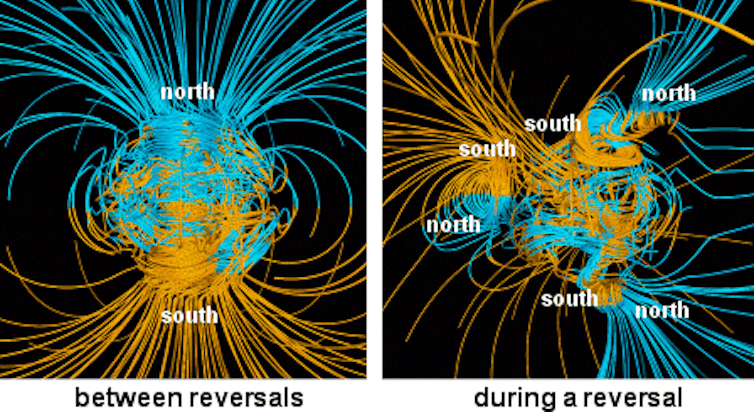The Earth’s magnetic field, generated 3,000km below our feet in the liquid iron core, is crucially important to life on our planet. It extends out into space, wrapping us in an electromagnetic blanket that shields the atmosphere and satellites from solar radiation.
Yet the magnetic field is constantly changing in both its strength and direction and has undergone some dramatic shifts in the past. This includes enigmatic reversals of the magnetic poles, with the south pole becoming the north pole and vice versa.
A long-standing question has been how fast the field can change. Our new study, published in Nature Communications, has uncovered some answers.
Rapid changes of the magnetic field are of great interest because they represent the most extreme behaviour of the ocean of molten iron in the liquid core. By tying the observed changes to core processes, we can learn important information about an otherwise inaccessible region of our planet.
Historically, the fastest changes in Earth’s magnetic field have been associated with reversals, which occur at irregular intervals a few times every million years. But we discovered field changes that are much faster and more recent than any of the data associated with actual reversals.

Nowadays satellites help monitor changes in the field in both space and time, complemented by navigational records and ground-based observatories. This information reveals that changes in the modern field are rather ponderous, around a tenth of a degree per year. But, while we know that the field has existed for at least 3.5 billion years, we don’t know much about its behaviour prior to 400 years ago.
To track the ancient field, scientists analyse the magnetism recorded by sediments, lava flows and human-made artefacts. That’s because these materials contain microscopic magnetic grains that record the signature of Earth’s field at the time they cooled (for lavas) or were added to the landmass (for sediments). Sediment records from central Italy around the time of the last polarity reversal almost 800,000 years ago suggest relatively rapid field changes reaching one degree per year.
Such measurements, however, are extremely challenging, with results still being debated. For example, there are uncertainties in the process by which sediments acquire their magnetism.





No comments:
Post a Comment